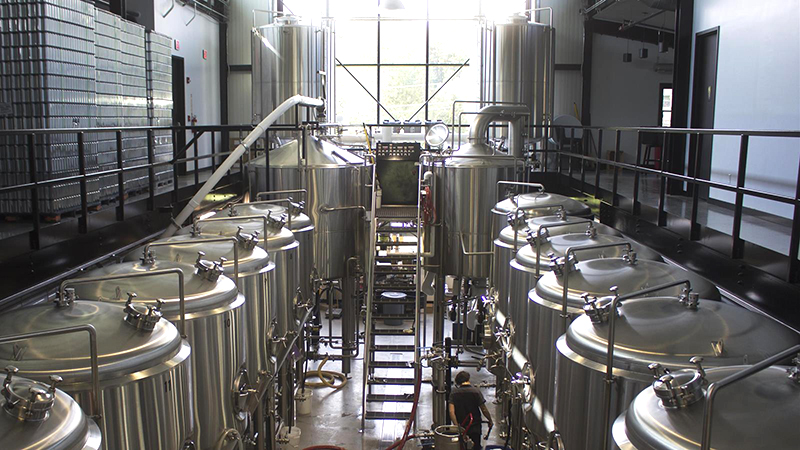
Is an air pollution control permit required for constructing or operating my brewery, hard cidery, winery, or distillery facility?
The quick answer is probably not. As of 2019 the Vermont Air Quality & Climate Division (AQ&CD) has only required air permits for two facilities in this sector: one for a hard cider facility (due to its large boilers) and the other for a whiskey distillery (due to aging in wooden barrels). Thus far, no breweries or wineries have been identified as needing an air permit.
The main sources of air pollution from the manufacture of alcoholic beverages are the evaporation of ethanol, and the pollutants emitted from the combustion of fuel to produce heat energy for building heat, process heat, etc. While ethanol is the desired attribute of an alcoholic beverage, when released to the atmosphere it leads to air pollution. Ethanol is considered a volatile organic compound that contributes to the formation of ozone pollution, one of the main components of “smog”.
Ethanol is released to the atmosphere during fermentation, transferring between process steps, cleaning, canning or bottling, and storage (especially if the storage vessel is a wooden barrel). If the AQ&CD estimates that 5 tons/year or more of ethanol are released to the atmosphere, then an air permit will be needed. The permit will require you to track and report your air emissions each year.
If the boiler(s) at the facility are large enough, then they might trigger the need for an air permit. More information please refer to our Boiler Page.
Shown below are some rough thresholds to help identify if a new facility, or an existing facility planning an expansion, will emit enough air pollution that an air permit is likely to be required. If your planned project is near these thresholds, please contact the AQ&CD so we can discuss the project.
Breweries and Hard Cider Facilities
Based on ethanol loss emission factors during fermentation and bottling, a brewery or hard cider facility with the capacity to produce more than 16,000,000 gallons/year of beer (or hard cider) is anticipated to be large enough to require an air permit due to the emission of ethanol. If your facility is this large, or a planned expansion will bring the facility’s total capacity above this threshold, then contact the Permitting Section of the AQ&CD so we can learn more about your facility and determine if an air permit is needed.
Wineries
Based on ethanol loss emission factors for fermentation, pomace screening and bottling, a winery with the capacity to produce more than 2,000,000 gallons/year of wine may be large enough to require an air permit. If your winery has this capacity, or a planned expansion will bring the winery’s total capacity above this threshold, then contact the Permitting Section of the AQ&CD so we can learn more about your facility and determine if an air permit is needed.
Distilleries
There are estimated to be very little loss of ethanol during the fermentation process and the subsequent distillation process at distilleries. Since the distillation process is designed to recover the ethanol rather than allow it to escape, the main source of ethanol emissions is from the aging of the distilled spirits in wooden barrels to produce whiskey. As the whiskey saturates the wooden barrel from within, some continues to diffuse through and evaporates to the outside. This evaporative loss can be as much as 2%, or more, of the total liquid every year and is referred to as the “Angel’s Share”. The production of spirits that do not involve aging in wooden barrels, such as vodka, is anticipated to have only a trivial amount of ethanol emitted to the atmosphere. If a distillery has the capacity to store more than 1,450 barrels of aging whiskey, then it is likely the distillery will need to have an air permit. Some craft products are also being aged in barrels (gin, beer, etc.). If the aging warehouse is storing a combination of whiskey and other products in wooden barrels, then total all the barrels to see if the 1,450 is exceeded. If you are over this 1,450 barrel threshold, please contact the Permitting Section of the AQ&CD so we can learn more about your facility and determine if an air permit is needed. Since beer has a lower alcohol content than distilled spirits and is likely not aged in the barrels as long as whiskey, it is not expected to lose as much ethanol from storage.
What Do I Need to do to Obtain an Air Permit?
Your first step should be to talk with one of the permitting engineers – it might turn out that a permit is not required. If you want to read more about the air permitting process, then please refer to our Permit to Construct Application Guidance webpage for more information. Another good source of information on air pollution from alcoholic beverage industry is the US EPA document AP-42 (see section 9.12) Note that if a permit is required for a proposed project, you cannot commence construction until the permit has been issued.
What other permits or requirements may be applicable to my project?
The Department of Environmental Conservation Environmental Assistance Office provides permit assistance through the Permit Navigator tool. The Permit Navigator can help you identify what environmental permits you may need for a project on a single parcel. If you have a linear, polygon, or multi-parcel project, contact a Community Assistance Specialist to get started.
